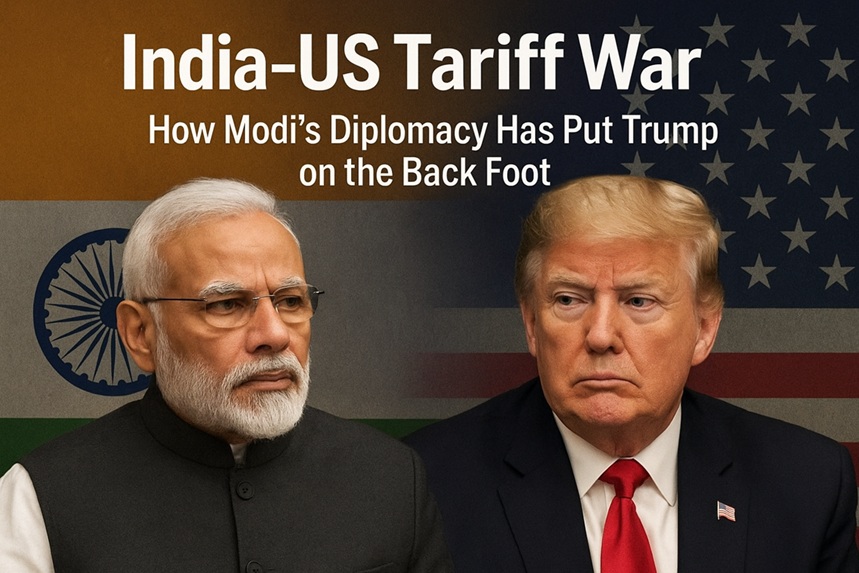In a surprising twist to the escalating India–US tariff war, U.S. President Donald Trump’s aggressive rhetoric has been met with an uncharacteristic silence. Just days ago, Trump slapped an additional 25% tariff on Indian imports, pushing the total duty to an unprecedented 50% — the highest against any U.S. trading partner — and warned of “further action within eight hours.”
Yet three days later, the White House has gone quiet. No new sanctions. No fresh announcements. And certainly, no repeat of Trump’s trademark bombast. This sudden retreat has sparked intense speculation about what happened behind the scenes — and how Prime Minister Narendra Modi’s calculated diplomacy may have turned the tide.
The Four Dimensions of the Tariff Crisis
Analysts point to four interconnected factors shaping the current deadlock:
Mounting Domestic Pressure in the U.S.
Inside Washington, Trump’s tariff move has triggered an unusual degree of resistance — not just from the opposition but also from within his own administration.
Pentagon and State Department officials have reportedly voiced concerns that the move jeopardises a quarter-century of steadily improving U.S.–India relations.
American economists and think tanks warn the tariffs are counterproductive, harming U.S. manufacturers, consumers, and strategic ties in Asia.
Indian-American lobbying groups have mobilised rapidly, framing the measure as an “economic self-goal.”
In a democratic system, such unpopularity matters. Trump, sensing the political backlash ahead of key elections, appears to be recalibrating his stance.
India’s Strategic, Not Reactive, Response
Unlike some nations that meet tariff hikes with immediate retaliatory duties, India has adopted a measured and multi-pronged approach:
Diversifying export markets to redirect goods previously bound for the U.S. towards regions like Southeast Asia, Africa, and Latin America — often at better margins.
Leveraging the crisis to push domestic manufacturing and self-reliance under “Make in India” and renewed calls for Swadeshi consumption.
Maintaining public composure — Modi has refrained from inflammatory statements, letting actions speak louder than words.
The result? Contrary to predictions of economic disruption, Indian markets have remained stable, signalling resilience and reducing Trump’s leverage.
High-Stakes Global Diplomacy
Behind the scenes, Modi has moved swiftly to rally international support and signal India’s strategic weight:
NSA Ajit Doval’s visit to Moscow for talks with President Vladimir Putin.
Modi’s upcoming visit to China, and Foreign Minister S. Jaishankar’s parallel diplomacy in Beijing.
Calls from leaders including Brazilian President Luiz Inácio Lula da Silva, pushing a united BRICS front.
Reports of coordinated pushback from multiple U.S. allies — Switzerland and Spain cancelling defence deals, and murmurs of Canada exploring alignment with BRICS trade policies.
Lula’s statement was particularly sharp: BRICS nations — already home to major U.S. tariffs — are discussing joint countermeasures that could shift the balance of global trade.
Legal and Political Vulnerabilities in the U.S. Tariff Decision
Trump’s legal authority to impose the tariffs is already under challenge in American courts.
Critics argue the “emergency powers” cited for the hike were designed for cybersecurity threats, not blanket trade measures.
Lower courts have flagged potential misuse of executive authority, warning that if the tariffs are struck down, the U.S. may have to refund collected duties — a political and fiscal embarrassment.
These legal uncertainties add another layer of risk, making a quick climbdown more attractive to the administration.
The Putin–Trump Meeting: August 15 Showdown
The next inflection point comes on August 15, 2025 — India’s Independence Day — when Putin and Trump are scheduled to meet in Alaska. The timing is symbolic and strategic:
For India, the day underscores its sovereignty and refusal to yield to economic coercion.
For Trump, the meeting may offer a face-saving off-ramp, possibly involving broader U.S.–Russia negotiations where India’s position will be a factor.
Diplomatic insiders suggest Modi’s engagement with both Moscow and Beijing is aimed at reshaping the negotiation landscape before Trump enters the room.
Why Trump Blinked
Trump’s uncharacteristic silence can be explained by a confluence of pressures:
Domestic political backlash from voters, industry, and policy circles.
India’s calm but decisive counter-strategy, which avoided open escalation while undermining U.S. leverage.
A rapidly consolidating anti-tariff bloc among U.S. allies and BRICS nations.
Legal fragility of the tariff order in American courts.
The White House now faces a stark choice: escalate further and risk economic isolation, or seek a compromise that allows both leaders to claim victory.
The Road Ahead
India’s posture in this crisis sends a clear message — it will not bow to unilateral trade bullying, nor will it abandon its independent foreign policy. Modi’s approach combines economic resilience, market diversification, and quiet but assertive diplomacy.
If August 15 brings even a partial softening of U.S. tariffs, it will be seen not just as a diplomatic win for India, but as a blueprint for how middle powers can push back against great-power economic coercion without firing a shot.
#trump #donaldtrump #dailydozes #pmmodi #tariffs #nsaajitdoval #25%tariff #trumptariffs #ajitdoval #sjaishankar #brazil #putin #alaska #tariffwars #usindiarelations #trade #lula #japan #independanceday #foreignpolicy #brics #bricsnation #russia #canada #russiaoil #indianeconomy #china #stockexchange
Discover more from DailyDozes NEWSPAPER
Subscribe to get the latest posts sent to your email.
